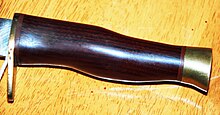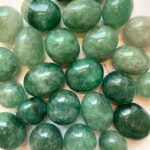Micarta is a composite material that has become increasingly popular in the crafting of knives, known for its durability, versatility, and unique aesthetic qualities.
It is a type of laminated plastic, primarily made from layers of fabric or paper soaked in a resin and then compressed to form a solid sheet.
The term “Micarta” is a brand name that has become synonymous with this type of material, though there are other similar composites on the market.
In the world of knife making, Micarta is highly valued for its exceptional strength, moisture resistance, and ability to take on a variety of textures and colors, making it an ideal choice for knife handles.
The Composition of Micarta
Micarta is crafted through a meticulous process that involves impregnating layers of fabric (such as linen, canvas, or paper) with a resin, typically epoxy, and then applying heat and pressure to cure the material. The result is a dense, durable sheet that can be machined into the desired shape. The fabric layers contribute to the material’s overall strength and durability, while the resin holds everything together. This construction process is what gives Micarta its unique properties, making it significantly stronger and more resilient than many natural materials like wood or bone.
The variety of fabrics used to create Micarta allows for a wide range of aesthetic outcomes. For instance, linen Micarta often presents a textured appearance, while canvas Micarta can offer a smoother finish. The layers within the Micarta material also give it a unique depth, with visible patterns that can vary depending on the fabric and resin combination used.
Why Micarta is Ideal for Knife Handles
One of the key reasons why Micarta is so popular for knife crafting is its incredible toughness. When used as a handle material, Micarta provides a strong grip that won’t slip, even in wet conditions. This is particularly important for knives used in tactical, hunting, or outdoor applications, where a secure grip is essential. The texture of Micarta can range from smooth to rugged, offering different levels of traction depending on the maker’s preference.
Additionally, Micarta is highly resistant to moisture and temperature changes. Unlike wood, which can swell, warp, or crack when exposed to humidity or extreme temperatures, Micarta remains stable and strong. This characteristic makes it a superior choice for knives that will be exposed to varying environmental conditions, such as those used for survival or bushcraft. The material’s resistance to water and chemicals also helps prevent degradation over time, ensuring a longer-lasting handle.
Durability and Longevity of Micarta Handles
The durability of Micarta makes it a practical choice for knife makers looking for long-lasting handle material. Not only does it resist moisture, but it also withstands impact and wear. When used for crafting knives, Micarta offers superior strength that can endure the rigors of everyday use without showing significant signs of wear or tear. This makes Micarta an excellent material for both high-performance knives and tools that see frequent use.
Moreover, Micarta has a high resistance to abrasions, which is essential for maintaining the integrity of a knife handle in harsh environments. Its ability to retain its shape and texture, even after extended exposure to rough conditions, contributes to the overall longevity of the knife.
Aesthetic Appeal of Micarta in Knife Crafting
One of the aspects that sets Micarta apart from other synthetic materials is its ability to combine functionality with aesthetic appeal. Knife makers can create handles with varying colors and textures by using different fabrics and resin combinations. Some Micarta handles are translucent, allowing the underlying fabric patterns to show through, while others have a solid, opaque finish with striking color contrasts.
Furthermore, Micarta takes on a patina over time, which adds to its character and visual appeal. This aging process enhances the natural look of the handle, making each piece unique and often more beautiful as it develops a richer, deeper color. For many knife enthusiasts, the evolving look of Micarta is a desirable feature, as it adds an element of personalization and individuality to the knife.
Versatility of Micarta in Knife Making
Micar ta offers remarkable versatility, making it a favorite among custom knife makers. Its ease of customization means that it can be crafted into handles of various shapes and sizes, making it suitable for a wide range of knives, from small folding knives to large tactical or survival blades. Knife makers can easily carve, sand, or polish Micar ta to achieve the desired finish, allowing for an extensive range of designs.
The ability to combine Micar ta with other materials, such as metals or wood, opens up further creative possibilities. For example, makers might add metal pins or bolster accents to a Micar ta handle for added flair and visual contrast. This versatility in design ensures that Micar ta can cater to the preferences of different knife makers, from those who prefer minimalist designs to those who enjoy more elaborate and ornate patterns.
The Advantages of Micar ta Over Other Materials
While there are numerous materials available for crafting knife handles, Micar ta stands out for its blend of durability, aesthetics, and functionality. Compared to natural materials like wood or bone, Micar ta is much more resistant to environmental factors such as moisture, extreme temperatures, and chemicals. While other synthetic materials may crack or degrade over time, Micar ta holds up exceptionally well, making it a long-term investment for knife enthusiasts.
In addition to its robustness, Micar ta also offers a level of consistency that natural materials often cannot provide. Since each sheet of Micar ta is produced using a controlled process, knife makers can count on uniformity in texture, color, and strength from batch to batch. This consistency makes it a reliable material for crafting high-quality knives that perform well in a variety of conditions.
Conclusion: Why Micar ta is a Top Choice for Knife Crafting
In conclusion, Micar ta is a material that combines strength, durability, versatility, and aesthetic appeal, making it an excellent choice for crafting knife handles. Its resistance to moisture, temperature fluctuations, and wear makes it a reliable material for knives that will stand the test of time. Furthermore, the ability to customize Micar ta handles to suit individual preferences allows for creativity and personalization in knife crafting. Whether you’re a professional knife maker or a hobbyist, Micar ta offers an ideal balance of form and function, providing a high-quality, long-lasting material that can elevate any knife.
With its unique properties and increasing popularity in the knife-making community, Micar ta continues to be one of the most trusted materials for crafting premium, durable, and visually appealing knives.





